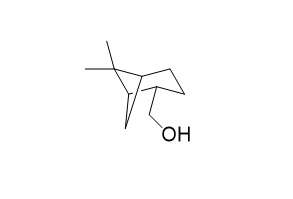(1S,2S,5S)-(-)-MyrtanolCAS# 53369-17-8 |

Quality Control & MSDS
Package In Stock
Number of papers citing our products

| Cas No. | 53369-17-8 | SDF | Download SDF |
| PubChem ID | N/A | Appearance | Oil |
| Formula | C10H18O | M.Wt | 154.3 |
| Type of Compound | Monoterpenoids | Storage | Desiccate at -20°C |
| Solubility | Soluble in Chloroform,Dichloromethane,Ethyl Acetate,DMSO,Acetone,etc. | ||
| General tips | For obtaining a higher solubility , please warm the tube at 37 ℃ and shake it in the ultrasonic bath for a while.Stock solution can be stored below -20℃ for several months. We recommend that you prepare and use the solution on the same day. However, if the test schedule requires, the stock solutions can be prepared in advance, and the stock solution must be sealed and stored below -20℃. In general, the stock solution can be kept for several months. Before use, we recommend that you leave the vial at room temperature for at least an hour before opening it. |
||
| About Packaging | 1. The packaging of the product may be reversed during transportation, cause the high purity compounds to adhere to the neck or cap of the vial.Take the vail out of its packaging and shake gently until the compounds fall to the bottom of the vial. 2. For liquid products, please centrifuge at 500xg to gather the liquid to the bottom of the vial. 3. Try to avoid loss or contamination during the experiment. |
||
| Shipping Condition | Packaging according to customer requirements(5mg, 10mg, 20mg and more). Ship via FedEx, DHL, UPS, EMS or other couriers with RT, or blue ice upon request. | ||
| Description | (1S,2S,5S)-(-)-Myrtanol shows anti-bacteria against nine harmful intestinal bacteria. | |||||

(1S,2S,5S)-(-)-Myrtanol Dilution Calculator

(1S,2S,5S)-(-)-Myrtanol Molarity Calculator
| 1 mg | 5 mg | 10 mg | 20 mg | 25 mg | |
| 1 mM | 6.4809 mL | 32.4044 mL | 64.8088 mL | 129.6176 mL | 162.022 mL |
| 5 mM | 1.2962 mL | 6.4809 mL | 12.9618 mL | 25.9235 mL | 32.4044 mL |
| 10 mM | 0.6481 mL | 3.2404 mL | 6.4809 mL | 12.9618 mL | 16.2022 mL |
| 50 mM | 0.1296 mL | 0.6481 mL | 1.2962 mL | 2.5924 mL | 3.2404 mL |
| 100 mM | 0.0648 mL | 0.324 mL | 0.6481 mL | 1.2962 mL | 1.6202 mL |
| * Note: If you are in the process of experiment, it's necessary to make the dilution ratios of the samples. The dilution data above is only for reference. Normally, it's can get a better solubility within lower of Concentrations. | |||||

Calcutta University

University of Minnesota

University of Maryland School of Medicine

University of Illinois at Chicago

The Ohio State University

University of Zurich

Harvard University

Colorado State University

Auburn University

Yale University

Worcester Polytechnic Institute

Washington State University

Stanford University

University of Leipzig

Universidade da Beira Interior

The Institute of Cancer Research

Heidelberg University

University of Amsterdam

University of Auckland

TsingHua University

The University of Michigan

Miami University

DRURY University

Jilin University

Fudan University

Wuhan University

Sun Yat-sen University

Universite de Paris

Deemed University

Auckland University

The University of Tokyo

Korea University
- 2-(2-Hydroxybenzal)acetophenone
Catalog No.:BCN9883
CAS No.:644-78-0
- gamma-Decalactone
Catalog No.:BCN9882
CAS No.:706-14-9
- 5,7-Dihydroxy 3,3',4',5',6,8-hexamethoxyflavone
Catalog No.:BCN9881
CAS No.:96887-18-2
- Cymarin
Catalog No.:BCN9880
CAS No.:508-77-0
- Dihydroquinine
Catalog No.:BCN9879
CAS No.:522-66-7
- Tricaprin
Catalog No.:BCN9878
CAS No.:621-71-6
- Lyciumamide B
Catalog No.:BCN9877
CAS No.:1647111-41-8
- 4-Hydroxyisophthalic acid
Catalog No.:BCN9876
CAS No.:636-46-4
- Syringetin
Catalog No.:BCN9875
CAS No.:4423-37-4
- Norharman
Catalog No.:BCN9874
CAS No.:244-63-3
- 2-(4-Hydroxybenzal)acetophenone
Catalog No.:BCN9873
CAS No.:20426-12-4
- Condurango glycoside A
Catalog No.:BCN9872
CAS No.:11051-90-4
- 6-Methoxyflavanone
Catalog No.:BCN9885
CAS No.:3034-04-6
- 15-Deoxypulic acid
Catalog No.:BCN9886
CAS No.:95523-05-0
- 4-Oxadocosane-1,2-diol
Catalog No.:BCN9887
CAS No.:544-62-7
- Tribulosin
Catalog No.:BCN9888
CAS No.:79974-46-2
- Cinnamtannin A2
Catalog No.:BCN9889
CAS No.:86631-38-1
- Tryptamine hydrochloride
Catalog No.:BCN9890
CAS No.:343-94-2
- Caffeoyl alcohol
Catalog No.:BCN9891
CAS No.:3598-26-3
- 5-Geranoxy-7-methoxycoumarin
Catalog No.:BCN9892
CAS No.:7380-39-4
- (-)-Linalool
Catalog No.:BCN9893
CAS No.:126-91-0
- Methyl anthranilate
Catalog No.:BCN9894
CAS No.:134-20-3
- 3-Octanone
Catalog No.:BCN9895
CAS No.:106-68-3
- Decanoic acid
Catalog No.:BCN9896
CAS No.:334-48-5
Growth-inhibiting effects of Paeonia lactiflora root steam distillate constituents and structurally related compounds on human intestinal bacteria.[Pubmed:22805939]
World J Microbiol Biotechnol. 2012 Apr;28(4):1575-83.
The growth-inhibiting activities of Paeonia lactiflora (Paeoniaceae) root steam distillate constituents and structurally related compounds against nine harmful intestinal bacteria and eight lactic acid-producing bacteria were compared with those of two antibiotics, amoxicillin and tetracycline. Thymol, alpha-terpinolene, (-)-perilla alcohol and (1R)-(-)-myrtenol exhibited high to extremely high levels of growth inhibition of all the harmful bacteria, whereas thymol and alpha-terpinolene (except for Lactobacillus casei ATCC 393) inhibited the growth of all the beneficial bacteria (MIC, both 0.08-0.62 mg mL(-1)). Tetracycline and amoxicillin exhibited extremely high level of growth inhibition of all the test bacteria (MIC, <0.00002-0.001 mg mL(-1)). 1,8-Cineole, geraniol, (-)-borneol, (1S,2S,5S)-(-)-Myrtanol, nerol, (S)-(-)-beta-citronellol and (+/-)-lavandulol also exhibited inhibitory activity but with differing specificity and levels of activity. Structure-activity relationship indicates that structural characteristics, such as geometric isomerism, degrees of saturation, types of functional groups and types of carbon skeleton, appear to play a role in determining the growth-inhibiting activity of monoterpenoids. Global efforts to reduce the level of antibiotics justify further studies on naturally occurring P. lactiflora root-derived materials as potential preventive agents against various diseases caused by harmful intestinal bacteria such as clostridia.


